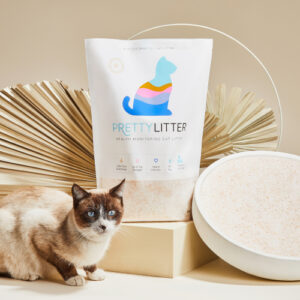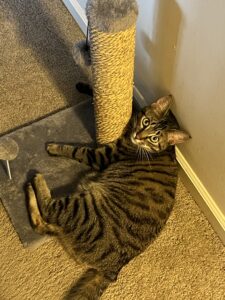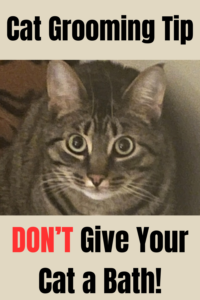Owning a cat is one of the most rewarding experiences you’ll ever have. Cats provide so much love, affection, companionship, emotional support and entertainment! I’m glad you’re taking the time to learn how to take care of a cat.
👉 Learn to Speak Your Cat’s Language with The Cat Language Bible!
How to Care for a Cat
Let’s talk about the most important aspects of cat care. These cat care tips will help you get you and your cat set up for a happy, healthy life together!
In this post, we’ll cover:
-
- Cat Health
- Feeding Your Cat
- Litter Box Training
- Exercising Your Cat
- Cat Grooming
- Cat Scratching
- Cat Nail Clipping
- Flea and Tick Protection for Cats
- Cat Safety
- Cat Supplies
- Cat Training
We’ll also discuss how to decide if your cat will be an indoor or an outdoor cat.
Watch My Video: How to Take Care of a Cat
This post contains affiliate links. If you make a purchase, I’ll earn a commission (at no extra cost to you). As an Amazon Associate, I earn from qualifying purchases. I donate 10% of my earnings to animal charities.
Cat Health Care
As soon as you get a cat or kitten, you should establish them as a patient with a nearby veterinarian. Ask for recommendations from friends and family to find out where they take their pets.
Both kittens and adult cats need to receive necessary vaccinations and it’s important to have your cat spayed or neutered.
Your cat should be spayed or neutered by about six months old. If you need help paying for this, read my article, Free Spay or Neuter Clinics.
Cat Health Insurance
You might consider getting an inexpensive pet health insurance for your cat to help cover their medical expenses throughout their life.
For advice on this, read this article:
Is Cat Insurance Worth the Cost?
Also, get a folder of some sort from your local dollar store and use it to keep all medical records for your cat. You might also ask your vet to send you a reminder card in the mail whenever your cat is due for a checkup or vaccinations.
My top recommendation for pet health insurance is Lemonade.
For information about veterinary care for cats, read my article, Indoor Cat Health – What Veterinary Care Do They Need?
Feeding Your Cat
I suggest you ask your vet for advice for feeding your cat. Kittens should eat kitten food until they’re a year old, then you can switch to adult cat food.
Be sure to provide fresh drinking water at all times and wash their food and water bowls frequently. I rinse pet food and water bowls daily and wash them with soap and water weekly.
Best Food for Cats
You should also be aware that cats need wet food in their diet. A veterinarian once told me, “If you give a dog a bowl of water, he’ll drink half the bowl. If you give a cat a bowl of water, they’ll drink a thimble full.”
He told me that when my elderly cat was diagnosed with kidney disease. I fed her dry cat food all her life, not realizing she wasn’t getting enough hydration. For more about this, watch my video, What Should You Feed Your Cat?
You should always feed your best the best qualify food you can afford. That’s first and foremost. But if you can afford to, I highly recommending feeding your cat fresh cat food. The health benefits are extraordinary and your cat will love you for it! My recommendation for fresh cat food is Smalls.com.
For more information on feeding your cat, read my article, What is the Best Food for My Cat – Canned Cat Food vs Dry Cat Food.
You should also be aware of which foods you should not share with your cat.
The Cat Litter Box
Your cat’s litter box should be in a quiet, accessible location. Avoid moving the litter box or changing the litter as cats are extremely sensitive to change and may stop using the litter box if the change is too abrupt.
If you must move the litter box, move it slowly, a little each day, toward the new location.
If you must change the litter, start mixing it in a little at a time, gradually increasing the new litter vs old litter. You should scoop the litter box at least once a day, add fresh kitty litter once or twice per week, and empty and wash the litter box with dish soap and hot water about once per month.
Do not use strong smelling cleaners like bleach, lemon or ammonia to clean the litter box. Cats have an incredibly strong sense of smell, and these cleaners may keep them from using the litter box or at minimum, it’ll be uncomfortable for them.
Litter Box Training
For help with litter box training and to prevent any problems, read these articles, How to Get Your Cat to Use the Litter Box – Stop Your Cat from Peeing Everywhere! and How to Stop a Cat from Urinating in the House – 10 Reasons Why Your Cat Won’t Use the Litter Box.
For information on choosing a cat litter, read my article, What is the Best Cat Litter? Here’s the Scoop!
I’ll be giving you a recommendation later in this post about cat training. My top recommendation for litter box training and training for bad cat behavior is the Complete Cat Training Guide. More on that in a bit…
Exercising Your Cat
Your cat will need daily exercise to burn calories, to burn energy, for mental stimulation and to stay healthy. You should provide a few toys for your cat. You also might consider providing interactive cat toys to keep your cat occupied when you’re not home.
Cats who get enough exercise will have fewer behavioral issues and playing with your cat every day is good for your health and happiness as well!
I find feather toys and laser light toys are the best way to get my cat to play and it’s great exercise for them. For more information on keeping your cat healthy and happy, read my article, How to Keep Indoor Cats Happy.
Cats Need to Scratch!
Cats scratch for a variety of reasons.
You should also provide your cat with a scratching post.
The image on the left is the one I bought for my cat, Whiskers. As you can see, he loves it. LOL I also suggest reading my article, How to Stop a Cat from Scratching Furniture.
Cat Nail Trimming
Trimming your cat’s nails regularly will help to keep this under control. If you take it slow and be patient with your cat, they’ll eventually allow you to trim their nails at home yourself.
But if you don’t want to, most veterinary offices will do a quick nail clipping at regular appointments or even as a quick service as needed (ladies, kind of like how our hairdresser will trim our bangs in between haircuts!).
For more help on how to do this, my article, How to Cut a Cat’s Nails at Home for help on this.
Cat Grooming
Please don’t give your cat a bath. Most cats do not need to be bathed by their owners. They’re meticulous grooming habits make that completely unnecessary. Brushing your cat will help them to keep their coat clean and help reduce hairballs.
If your cat doesn’t groom itself or cannot for some reason, ask your veterinarian for advice about whether to bathe the cat and how to do it.
Bathing a cat can be extremely stressful for your cat. For more about that, watch my video, Don’t Bathe Your Cat! It shouldn’t be done unless it’s absolutely necessary, and this includes flea baths. They don’t work…read on for better advice.
Cat Flea and Tick Protection
It’s important to protect your cat (and you and your home!) from ticks and fleas. For help on this issue, read my article, How to Get Rid of Fleas and How to Prevent Getting Them in the First Place.
Cat Safety
Identification. If your cat is allowed outside, they should wear a safety collar and an ID tag. A safety collar is one that will break loose if the collar gets caught on something. You should put a tag on your cat’s collar with their name and your phone number.
You can get these at PetTags.com. You might also consider a microchip. Ask your veterinarian for advice about microchipping.
Indoor vs Outdoor Cats
Please keep your cat indoors. Outdoor cats don’t live as long as indoor cats because they get run over by cars, get into fights with other cats (and racoons and other various animals).
They can get attached, injured or killed by neighborhood dogs, as well as coyotes.
Outdoor cats are also more likely to become infected with various diseases as well as getting fleas and ticks. Refer to the article I mentioned early on how to keep your cat happy indoors.
For input on this issue from Jackson Galaxy (from that show My Cat from Hell on Animal Planet), watch his video here.
That’s my boy, Whiskers in the pic. Isn’t he beautiful? You can see some cute videos of Whiskers on my YouTube Channel.
Leaving Your Cat Home Alone
You should make sure your cat is comfortable and safe whenever you’re not at home. For lots of help on this issue, read my article, Leaving Your Cat Home Alone – Tips for Safety and Comfort for Your Cat or Kitten.
If you have to be gone for long periods of time, read my article, How to Find a Good Cat Sitter.
Cat Supplies
Supplies. Here’s a list of cat care essentials for your cat (request printable list below). If you use these links to purchase your supplies, I’ll receive a small commission. I donate 10% of my earnings to animal charities.
Canned Cat Food
Dry Cat Food
Food and Water Bowls
Cat Toys
Interactive Toys
Cat Brush
Safety Collar
ID Tag
Scratching Post
Litter Box
Kitty Litter
Pretty Litter
Cat Carrier
Cat Bed
Cat Blanket
For Help with Cat Training
If you’d like help with your cat’s behavior, I can recommend a very good resource for cat training called, Complete Cat Training Guide. This Ebook has step-by-step instructions on how to solve 25 cat behavior problems. It’s a fantastic cat care guide for new cat owners.
For More Help Taking Care of Your Cat
- How to Take Care of a Cat
- How to Bond with Your Cat
- How to Keep Indoor Cats Happy
- How to Find a Good Cat Sitter
- How to Cut a Cat’s Nails at Home
- How to Keep Your Cat Indoors
- How to Understand Cat Language
- How to Find a Lost Cat
- What’s in Kitty Litter?
- What Is the Best Cat Litter?
- Tips for Traveling with Cats – Plan Ahead!
- Cat Boarding
- How to Adopt a Cat
- Back in the Barn: Touching Story for Cat Lovers
I Donate to Animal Charities
Thank you for visiting my website. I hope this post helps you to be the best cat owner you can be!
I donate 10% of my profits to animal charities. You can see a list of the charities I donate to here. If you like this website, please share it with your friends and family who have a cat or a dog. Thank you! Debra






















THE PART ABOUT WTHER OR OR NOT YOUR CAT SHOULD BE INDOOR OR OUTDOOR IS MISSING THE BEST WAY TO FOR YOUR CAT TO BE: INDOOR/OUTDOOR CAT! THIS HELPS THEM GET ALL THEY NEED!